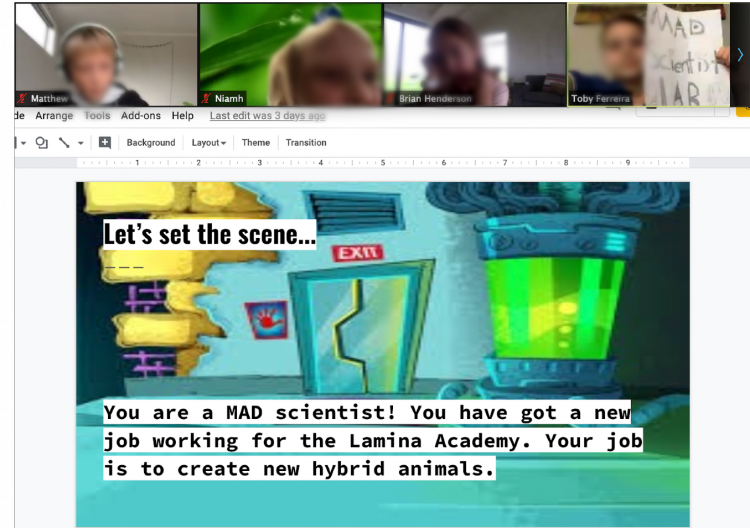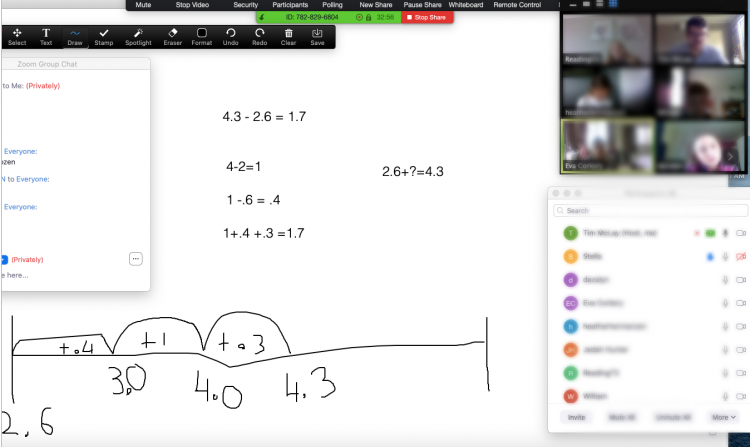Distance teaching and learning at Newbury School
Tags: Distance learning | Home-school partnership | Communication | Primary |
The COVID19 pandemic in 2020 meant that schools had to adapt quickly to students learning from home. At rural Newbury School, 5km from Palmerston North, this challenge presented new opportunities for teachers to engage with their students and community using technologies.
The school had to meet the needs of teachers, students and whānau as they moved to distance learning. Particular consideration was given to:
- maintaining wellbeing during a stressful time
- adapting learning and teaching from primarily done at school to done entirely away from school
- setting up new routines and ways of communicating between teachers, students and whānau
- ensuring ready access to technologies to support learning and communication.
The apprehension at the start was that we're going to be in people's homes. They're going to be seeing our practice. They're going to be seeing that day to day. But actually trusting and believing that what you do is really good stuff. And the feedback from our parents has been, you know, "what a fantastic teaching team we have, how exciting they make learning."
– Simon Marshall, Principal, Newbury School
Values-based distance learning
The school deliberately started from their DRIVE values as a way to anchor their new ways of distance learning to familiar contexts. Their DRIVE values align with the key competencies from The New Zealand Curriculum.
| Drive values | Key competencies | |
| D | Determined and confident | Participating and contributing |
| R | Respectful | Relating to others |
| I | Inspired leaders | Participating and contributing |
| V | Visionary – Innovative and creative | Thinking |
| E | Empowered and agentic | Managing self |
One of the things that we've really enjoyed about distance teaching and learning was the opportunity that it's afforded for some of our learners to really develop those DRIVE values.
– Simon Marshall, Principal, Newbury School
Principal Simon Marshall explains their school values came to the fore in distance teaching and learning. Collaborative activities worked best with learners having the opportunity to engage with one another. Being able to reconnect with their friends and teachers was important for students.
I feel the relationship between home, school and learner has been really strengthened during the lockdown. Distance teaching and learning has really, truly opened the doors for whānau to see the fantastic work that our teachers do.
– Simon Marshall, Principal, Newbury School
Approaches to learning beyond the classroom
Distance learning provided teachers with opportunities to engage differently with their students. The teacher's role was more of a coach. Detailed planning was important, particularly if there were technical issues. Teachers ran small group sessions to target learners' specific needs. They found there were fewer distractions online than in a classroom.
The piece of advice that I would give to teachers around us and teaching and learning is to give it a go and to be excited about the opportunities that will be created for building those relationships with your parents and your class and whānau. It's really powerful.
– Simon Marshall, Principal, Newbury School
Effective teaching approaches for distance learning
- Build relationships and develop a class culture based on mutual respect, care, empathy and warmth. Attend to and ensure the emotional wellbeing of each student.
- Establish a careful sequence of content to be covered, which builds logically and consistently through a series of well-designed and clearly focused tasks.
- Design learning activities in keeping with the principles of how we learn so as to avoid cognitive overload and to facilitate an understanding from comprehension to remembering, to understanding and the engagement with higher-order thinking skills.
- Support students to effectively manage their time, establishing routines and habits and establishing clear expectations for what students will be doing.
- Ensure plenty of opportunities for free play, for time in nature, for creative engagement, and rest.
Lessons from lockdown: initial questions and considerations for schools and education , The Education Hub
Consistent expectations
Taking a consistent approach to distance teaching and learning was important so that teachers, students and whānau all knew what to expect.
Expectations agreed by teachers
- Record teaching sessions and whānau time so learners can refer back to them if they miss them.
- Create a Google Drive folder and share the link with families and whānau in your class, so they have easy access to all relevant material in one place.
- Use Zoom as a common tool when teaching and connecting with families.
- Other platforms may also be used, such as Google Classroom, SeeSaw, Blogger to share learning with your class.
- Reading, writing and maths teaching sessions should happen each day. What this will look like will vary from class to class and group to group.
- A mixed model of explicit teaching, as well as independent learning will work well, so while there will be lots of independent tasks our learners can carry out at home, there will also be teaching sessions happening through Zoom.
- It may be that teachers want to work in collaborative pairs to deliver some of this learning; however, each teacher should check in each day with their class to continue to maintain a sense of community.
- Everyone to be online from 9am - 9.30am.
- Between 1.40pm - 2.30pm whānau and learners can book times with teachers to discuss learning or specific concerns. This will be done by 5pm the evening prior so teachers can manage their day.
- Inquiry will be based around the DRIVE values.
The expectations that we had for our whānau was that they would engage in those sessions and do their best to enable the learning and their children to be able to engage, too.
– Simon Marshall, Principal, Newbury School
Equitable access to devices
As the likelihood of a lockdown was looking more and more probable, the leadership team decided to take the unusual step of sending some learners home with school devices so they could access distance teaching and learning.
One of our school DRIVE values is aimed at developing our learners to become more empowered. This value has certainly been developed during lockdown. Our learners have been engaging independently and to varying degrees, choosing what learning they will work on and when they will complete the learning by.
– Simon Marshall, Principal, Newbury School
Strengthening the home-school partnership
Connecting and collaborating with whānau was a major focus. Building a partnership that worked for all participants was important, rather than a one-size-fits-all approach.
The key to us being successful is lots of collaborating with our learners’ families and whānau and being prepared to “fail fast” if things aren’t working – being reflective and looking for improved ways of providing quality teaching and learning for our classes.
– Simon Marshall, Principal, Newbury School
Using Google forms and regular emails to find out information and encourage two-way communication with parents helped strengthen connections between home and school. Parents had the opportunity to really engage with their children's learning.
The school communicated three different options for families to choose from when selecting a distance teaching and learning approach:
- Option 1 – Choose for your child to engage on a daily basis with teaching and learning.
- Option 2 – Choose to engage sporadically when it suits you and your family or whānau.
- Option 3 – Choose to not engage at all and provide other learning opportunities for your child.
The three levels of engagement for our families has worked really well. What it meant is that there's some clarity for them in terms of how regularly their children are going to be engaging, clarity for us as a teaching team, how regularly the learners are gonna be engaging and taking part in those sessions. And it just means that everybody's on the same page.
– Simon Marshall, Principal, Newbury School
Communications technology
The school wanted to have a consistent video conferencing platform across every class for ease of use for their parents and whānau. They wanted an option that was web-based and didn’t require the user to download anything or create an account if they didn’t want to. It was also important that a platform was selected which could be used on a wide variety of devices. Security was also a major consideration.
After consulting with an IT expert, the school chose to standardise on the Zoom platform.
More information »
Online safety
Well-being of students, teachers, and whānau was of paramount importance during the lockdown, including online safety.
Tools for online safety
The school supported its community with online safety by providing links to reputable information sources.
A simple, FREE way to block the worst of the web. Supported by the Ministry of Education, N4L, and Netsafe.
Online safety hub for parents and caregiver
Includes the Online safety parent toolkit - a practical seven-step framework to help parents. It explains the online challenges young people are likely to encounter, how to best support them, and what parents can do to teach their child to have a safer online experience.
How the meeting host can use the security capabilities to protect Zoom meetings.
The school ran several team sessions on using Zoom safely and how to maximise security features. They communicated these to their community so they could implement the same settings and security measures themselves.
As a team, we were conscious that there might be some of our families who didn’t want their child to be on Zoom during live sessions. As a result, we agreed to record each of our teaching and learning sessions to upload to a shared Google Drive folder which our families could access. This meant that, for those not wanting their child to take place during live sessions, they would be able to access sessions. It also meant that, for families who weren’t able to access these live sessions due to work/family commitments, they were still able to access the teaching and learning sessions at a time which suited them.
– Simon Marshall, Principal, Newbury School
Resources
Some of the elements of the distance teaching and learning that we're going to take into the more physical space is the power of technology. And whilst our teachers understood that previously, I think having had the opportunity and having the time to be able to explore some of those resources that are online has been really powerful for our teachers.
– Simon Marshall, Principal, Newbury School
The school found these resources particularly valuable for their learning programmes.

